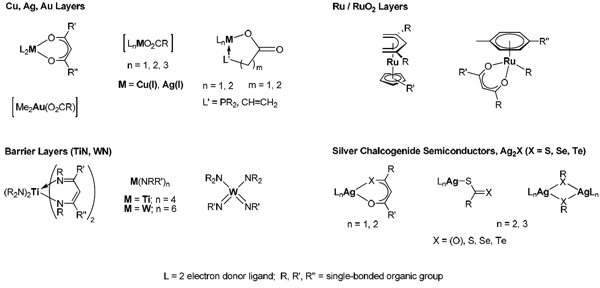Second project period 10/2010 - 03/2015
| Project No. | Project Name | Responsible |
|---|---|---|
| G5 | Precursor synthesis for advanced interconnect systems | Prof. Dr. Heinrich LANG |
Main Objectives
- Precursor synthesis for CVD, ALD, Spin-Coating deposition techniques, particularly copper, silver, gold, ruthenium
- Magnetic, electrical and catalytic nanoparticles
- One dimensional nanomaterials
Decsription
Most film and particle formation techniques for advanced interconnects and nanomaterials in micro- and nanoelectronics can be divided into liquid and gas phase deposition processes. Within this research project we will focus mainly on ALD (= Atomic Layer Deposition) and partly on CVD (= Chemical Vapor Deposition). While CVD allows to deposit thin layers of various materials with thicknesses between 0.1 – 10 µm, ALD controls film growth at atomic scale as fine as 10 pm (per monolayer). In comparison to CVD, ALD enables accurately to control the layer thickness depending on the number of reaction cycles, allowing large area capability, high conformality and reproducibility. This makes ALD attractive for micro- and nanoelectronics for manufacturing of future generation integrated circuits including high-k materials, ferroelectrics, metals and nitrides. [G5-1]
While in the first period of funding mainly copper and silver layers were deposited on various substrate materials by CVD, [G5-2] in the next phase ALD processes will be used to deposit conformal metals (Cu, Ru). In addition, mixed Cu/Ru layers (1 – 10 % of Ru) will be processed to investigate the catalytic influence of ruthenium on the growth and hence, properties of copper films. The primary goal is to cover CNTs (= carbon nanotubes) with such metal films for better contacting properties. Also coatings of silver and gold will be envisaged.
Metal nitride and metal oxide barrier layers will be formed by CVD and/or ALD techniques. A further topic to be investigated is the preparation of semi-conducting materials such as silversulfide, -selenide, and -telluride.
In this respect, in the proposed work we will concentrate on the synthesis of new copper(I), silver(I), gold(I, III), and ruthenium(II) precursors to be used in the ALD process (and partly CVD) for the deposition of the appropriate metals. In addition, precursor compounds for the generation of metal nitrides (TiN, WN) and silver chalcogenides (O, S, Se, Te) will be prepared. Figure 1 contains selected molecules to be synthesized.

|
|
Fig. 1: Selected molecules to be synthesized |
For the preparation of the molecules shown in Figure 1 efficient straightforward (consecutive) synthesis methodologies will be developed based on experiences gained in our group during recent years. [G5-3] The objective target of our studies includes the synthesis of appropriate molecules which are stable for months under normal conditions without decomposition. They will be characterized by elemental analysis, IR, NMR, UV-vis spectroscopy, and mass spectrometry. From selected samples – when solid – single X-ray structure determinations will be carried out. The decomposition mechanism of all precursors will be determined by TG-MS measurements and temperature- as well as in-situ mass spectrometry.
The deposition processes along with the parameters and their influence on layer properties will be evaluated together with the groups of Profs. Gessner (G3) and Schulz (G1). Film characterization will be carried out by the Hietschold (G8) and Zahn (G7) group. Together with Prof. Schmidt’s group Ag ALD will be provided to coat rolled-up nanotubes for on-chip energy storage (G9). The organometallics shown in Figure 1 will additionally used to deposit diffusion barriers, new high/low-k dielectrics and copper/ruthenium interconnects. For research project G6 (Prof. Albrecht) we will prepare appropriate magnetic metal (Fe, Co, FePt, FePd) and metal oxide (Fe3O4, Co3O4, NiO) nanoparticles from metal carboxylates. [G5-4]
References
| [G5-1] | a) Kodas, T.; Hampden-Smith, M.; The Chemistry of Metal CVD, VCH, Weinheim, (1994). b) Lang, H.; Buschbeck, R.; Deposition of Metals and Metal Oxides by Means of Metal Enolates in The Chemistry of Metal Enolates, Zabicky, J. (Ed.), John Wiley & Sons Limited, Chichester, (2009). |
| [G5-2] | a) Roth, N.; Jakob, A.; Wächtler, T.; Schulz, S.E.; Gessner, T.; Lang, H. Phosphane copper(I) complexes as CVD precursors. Surf. Coat. Technol. 201 (2007) 9089. b) Schmidt, H.; Shen, Y.; Leschke, M.; Haase, T.; Kohse-Höinghaus, K.; Lang, H. Phosphanstabili¬sierte Silber(I)-carboxylate: Synthese und Verwendung in der Silber-CVD. J. Organomet. Chem. 669 (2003) 25. |
| [G5-3] | Jakob, A.; Shen, Y.; Wächtler, T.; Schulz, S.E.; Geßner, T.; Riedel, R.; Fasel, C.; Lang, H. Z. Anorg. Allg. Chem. 634 (2008) 2226. b) Jakob, A.; Schmidt, H.; Djiele, P.; Shen, Y.; Lang, H. Phosphane/phosphite silver(I) carboxylates as CVD precursors. Microchim. Acta 156 (2007) 77. |
| [G5-4] | Steffan, M.; Jakob, A.; Claus, P.; Lang, H. Catal. Commun. 10 (2009) 437. |




